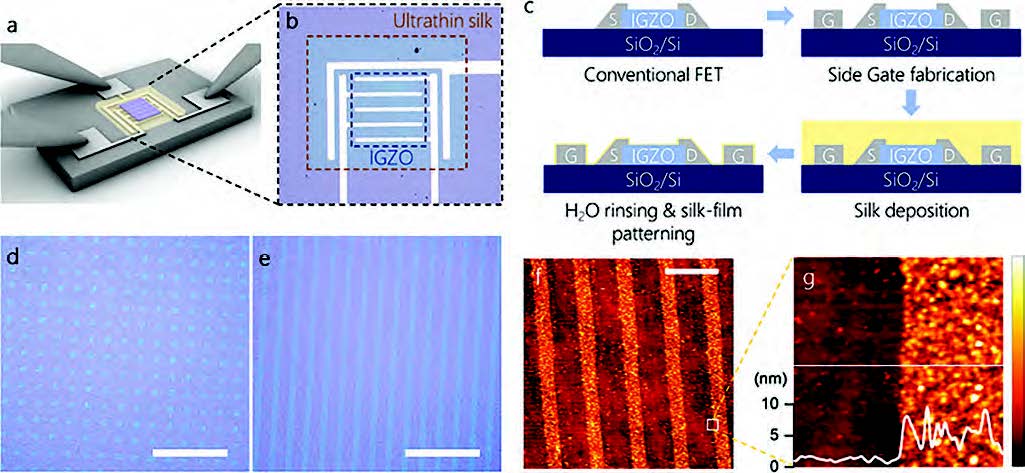| Oct 24, 2023 | |
Silk nanointerfaces merge biology and electronics |
|
| (Nanowerk Spotlight) Our breath can reveal a lot about our health. Tiny molecules in our exhaled air provide clues to everything from lung disease to diabetes. That’s why researchers are keen to develop ever-more-sensitive breath sensors, capable of detecting tell-tale compounds with precision. Now scientists report a new type of organic electronic sensor that leverages the unique properties of silk to achieve unprecedented sensitivity and speed. | |
| The new device, described in a paper published in Advanced Materials ("Bimodal Gating Mechanism in Hybrid Thin-Film Transistors Based on Dynamically Reconfigurable Nanoscale Biopolymer Interfaces"), is the brainchild of a team at Tufts University led by Fiorenzo Omenetto. For years Omenetto’s lab has pioneered techniques to control and pattern silk fibroin, the structural protein that gives silk its remarkable properties. | |
| By combining silk with traditional semiconductor technology, the researchers have created a flexible transistor that can switch between two modes of operation by simply absorbing moisture from breath. | |
 |
|
| Silk-FET architecture and fabrication. a) Graphic representation of an IGZO silk-FET with lateral gate electrode interfaced with an ultrathin silk layer, with b) a microscopy image of the device. c) Fabrication schematics. d,e) Microscopy images of the ultrathin silk films patterned in squares (d) and stripes (e) on a Si/SiO2 substrate (scale bars: 50 µm). f,g) Atomic force microscopy images of stripe-patterned silk films (scale bar: 10 µm) and the profile (inset of (g)). (Reprinted with permission by Wiley-VCH Verlag) | |
| The key lies in biopolymer layers just a few nanometers thick. “We can control the thickness of these silk films down to the nanoscale,” explains Omenetto. This lets researchers optimize the way the material interacts with water molecules. The transistors are built on a base of IGZO, a versatile semiconducting oxide also used commercially in flat-panel displays. | |
| When the device is dry, silk layers just 3-5 nanometers thick sit passively atop the IGZO, allowing the transistor – referred to by the researchers as a “silk-FET” – to operate via traditional semiconductor physics. But when the silk-FET absorbs moisture, its properties change radically. | |
| The water allows positive and negative ions to align at the silk’s interfaces, forming so-called electric double layers with papers stacked electrically like the plates of a nanoscale capacitor. This enables a completely different mode of operation called electrolyte gating, which generates up to a million times more current when the transistor is switched on. Even tiny amounts of water are enough to flip the switch. The scientists attribute this dual-gating mode solely to the presence of water molecules. | |
| The ability to toggle between the two modes simply by absorbing traces of water from breath creates an ultra-sensitive sensor. As someone exhales onto the device, current ramps up in just 30 milliseconds as water vapor allows electrolyte gating to kick in. When dry air is inhaled, the transistor switches back to standard operation in 300 ms. This rapid response allows the sensor to trace each inhalation and exhalation over multiple breath cycles with fidelity. | |
| Omenetto’s team leveraged this capability to build a fast and highly sensitive breath monitor. Abnormal breathing patterns are associated with conditions like sleep apnea, asthma, and even heart problems. But most sensors lag behind the pace of each breath. “Our devices can precisely track respiratory dynamics thanks to response times that outperform current state-of-the-art technologies,” says Omenetto. | |
| His group integrated an array of the silk transistors on a surgical mask to demonstrate how their creation could monitor breathing rate in real time even as the wearer talks or moves. Device sensitivity could be tuned further by introducing compounds in the silk film matrix that respond to specific biomolecules in each exhaled breath. | |
| The work underscores silk’s versatility as a high-tech material. “We can engineer the nanoscale properties of silk films and seamlessly integrate them with traditional electronics,” explains Omenetto. | |
| Lightweight, flexible, biocompatible silk could complement rigid silicon chips or metal electrodes in next-gen bioelectronics. The researchers say their transistors could find use in everything from diagnostics to soft robotics. But Omenetto stresses that silk still has much to teach us. “This provides a new perspective on the potential of biohybrid electronic nanointerfaces based on silk,” he says. | |
 By
Michael
Berger
– Michael is author of three books by the Royal Society of Chemistry:
Nano-Society: Pushing the Boundaries of Technology,
Nanotechnology: The Future is Tiny, and
Nanoengineering: The Skills and Tools Making Technology Invisible
Copyright ©
Nanowerk LLC
By
Michael
Berger
– Michael is author of three books by the Royal Society of Chemistry:
Nano-Society: Pushing the Boundaries of Technology,
Nanotechnology: The Future is Tiny, and
Nanoengineering: The Skills and Tools Making Technology Invisible
Copyright ©
Nanowerk LLC
|
|
|
Become a Spotlight guest author! Join our large and growing group of guest contributors. Have you just published a scientific paper or have other exciting developments to share with the nanotechnology community? Here is how to publish on nanowerk.com. |
|
